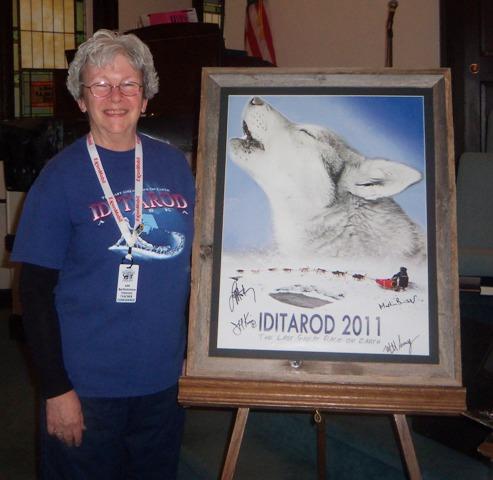The Iditarod: Through a Teacher's Eyes
At first glance, Ann Bartholomew, a petite woman, mom and grandmother of three, doesn’t seem like the sort you would find in Alaska at a race involving dog sleds and mushers, but that’s just where you would have found her in early March of this year. On Sunday evening, March 24th, she gave a presentation about the race at First Baptist church in Morgantown. Ann is the director of three hand bell choirs at the church.
The Iditarod, a thousand- plus mile race, run from Anchorage to Nome, Alaska, is dubbed the last great race on earth, and it’s easy to see why. The race takes place in sub-zero, rugged terrain that tests even the most expert mushers. “Alaska is not for the faint of heart,” Bartholomew told the Sunday evening crowd. She began her presentation decked out in the clothing that helped her brave the freezing temperatures, which included fleece-lined mittens, hat and neck gator, as well as a coat rated at 25 below zero, a snow bib, flannel lined jeans and boots rated to 45 below zero.
Bartholomew, a retired teacher from Woodbury, Tennessee ,she and husband, Dean, moved to Morgantown in order to be closer to their daughter and her family, became interested in the race after teaching the writings of Jack London and Gary Paulson, writers whose works are set in Alaska. A veterinarian in the Woodbury area was one of a team of fifty veterinarians from across the nation who volunteers their services during the race. He directed Bartholomew to some possible educator programs that might interest her. She found a fit in the Iditarod Winter Conference for Educators, sponsored by Exxon Mobil. The conference was established to help teachers promote math and science in the classroom, using information from the Iditarod as a springboard.
Bartholomew attended her first conference in 2007. In 2011, she was invited back as a presenter, teaching other educators how to incorporate the Iditarod in their math and science curriculum. She missed the race in 2012 due to treatment for cancer, but was able to return this year as strong and determined as ever. “It was a thrill to go back as a healthy person,” she said. The race itself was and is an inspiration for her daily life. The Iditarod employs the wisdom found in Hebrew 12:1, “Run with patience the race that is set before us…” she explains, “It took the winner nine days to complete this year’s race.”
Bartholomew’s presentation covered the kind of behind-the-scenes information that you would expect from a skilled educator. The first race (run in 1967) took three weeks. Most dogs entered in the race are Alaskan Huskies, but any dog can run as long as the dog has the undercoat of fur known as the arctic coat. The racers begin with as many as 16 dogs, and dogs can be dropped at checkpoints, but dogs can’t be added. A racer must finish with at least 6 dogs in harness to qualify for the win. Dogs do their best running in zero degrees temperature, and a team of vets examine the dogs at every checkpoint. A musher must be at least 18 years old to enter the race, and he or she must have competed in other top races. There is no upper age limit—this year’s oldest musher was seventy-three. The winner of the Iditarod receives fifty thousand dollars and a new Dodge pickup. The race doesn’t end until the last person finishes; the last person is presented with a red lantern and is met with the same kind of celebration given to the winner of the race.
“You don’t have to be first to be a winner,” Bartholomew says. Another life lesson garnered by an astute teacher.
The hand bell choir will present their next concert, under the direction of Ann Bartholomew, on May 19, at First Baptist church. The youth hand bell choir will perform in Woodbury Tennessee at the First Baptist church on April 21
Story by Cheryl Hughes, Beech Tree News
- Log in to post comments



























